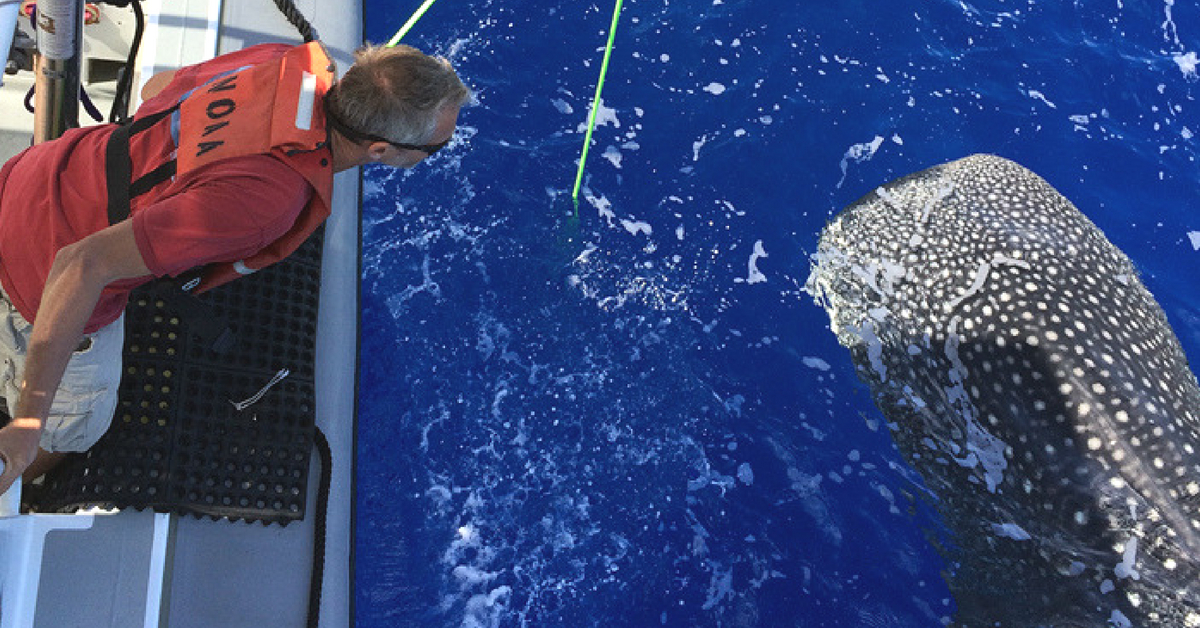Gujarat’s Gentle Giants: Local Fishermen Turn Saviors For the World’s Largest Fish!
But whale sharks are far off from the mainstream image of sharks. Firstly, they feed on plankton--copepods, krill, fish eggs, crab larvae and small squid or fish. Contrary to popular belief, they do not threaten humans.

The world’s largest known fish, the slow-moving, plankton-eating Whale Shark, has been the subject of human brutality for years. The 60 million-year-old species had to suffer under man’s hands because well, it was discovered to be somewhat of an oil reservoir.
Usually when you hear the word ‘shark,’ it sends us an image of a brutal fish with sharp teeth, always circling the water in search of prey. We have been told that sharks can smell blood and are instantly drawn to it. Much like Bruce from Finding Nemo, actually.
But whale sharks are far off from this image of sharks. Firstly, they feed on plankton–copepods, krill, fish eggs, crab larvae and small squid or fish. Contrary to popular belief, they do not threaten humans.
In fact, they are quite docile and much like dolphins, they might even allow deep-sea divers to hitch a ride! Although highly discouraged by shark scientists, this behaviour trait of the whale shark shows they are more friends to humans than foes.

Why did we hunt the whale sharks then? Well, until the 1980s, we extracted oil from their livers to polish wooden boats and make them waterproof. Even after the boat bitumen was readily available, the sharks were not safe. The demand for shark fin had risen in several countries.
According to a report by Traffic India, every fish caught in 2000 would bring the fishermen between Rs 40,000 and Rs 1,50,000. If the fishermen succeeded in getting four fins, the set would sell at anything between Rs 15,000 and Rs 30,000.
How would a fish that brought so much money and was in demand in so many countries ever be protected? The answer lay in sentiments.

Mike Pandey brought the massacre of Whale Sharks in mainstream conversations with his film, Shores of Silence. Traffic India had reported that 600 whale sharks were fished by humans between 1999 and 2000. A little less than the killing of two whale sharks per day, the activity can be safely called a massacre.
The Wildlife Trust of India (WTI) furthered the efforts of Mike Pandey by lobbying the importance of its conservation. In 2001, under the Indian Wildlife Law, whale sharks became the first fish to be protected.
Although these efforts were commendable at higher levels, it was the fishermen who needed to understand its cause more than anyone else. For instance, they did not know about the protection law three years after it was passed.
And so a religious leader hit home not with sermons or the fear of the law, but with a sentimental metaphor. It was believed that whale sharks usually live closer to Australia and travel to the Arabian Sea only to breed. The leader used this premature study to inspire fisherfolk in Gujarat to protect whale sharks instead of hunting them.
Setting a tangled whale shark free on the shores of Dwarka, he told the fisher folk that these sharks are like their daughters coming back home to give birth.

How could they fish the shark then, now that they considered them as their daughters?
This protected the whale shark living in the Arabian Sea near the Gujarat coast. WTI subsequently discovered that the fish does not come to Gujarat merely for breeding, but has made the Arabian Sea its permanent home, due to healthy living conditions. They tagged two sharks and tracked them for as long as they got signals from the tags.
Sajan John, a WTI researcher, told the Times of India, “Data from these tags, which remained operational for 350 days and 150 days, revealed that these animals remained mainly in the Arabian Sea and did not move towards the east coast of India. Their movements were confined to the Arabian Sea and towards Oman and the Somali coast.”
Having secured the protection of whale sharks from the Gujarat fisherfolk, the next challenge for the government was to help sharks that were accidentally caught in nets. They offered fisherfolk compensation of Rs 25,000 for each net destroyed if they set the shark free.
From 2005, when the scheme was initiated, until February 2018, the fishermen freed a total of 689 whale sharks!
Such efforts, some on the governmental level, some on an individual level, utilising both facts and sentiments have helped the cause of whale shark conservation. The docile large fish has, in so many cases, extended a friendly fin towards human divers.
Isn’t it time for us to shake hands in an alliance?
(Edited by Shruti Singhal)
Like this story? Or have something to share?
Write to us: [email protected]
Connect with us on Facebook and Twitter.
NEW: Click here to get positive news on WhatsApp!
This story made me
- 97
- 121
- 89
- 167
Tell Us More
We bring stories straight from the heart of India, to inspire millions and create a wave of impact. Our positive movement is growing bigger everyday, and we would love for you to join it.
Please contribute whatever you can, every little penny helps our team in bringing you more stories that support dreams and spread hope.



















